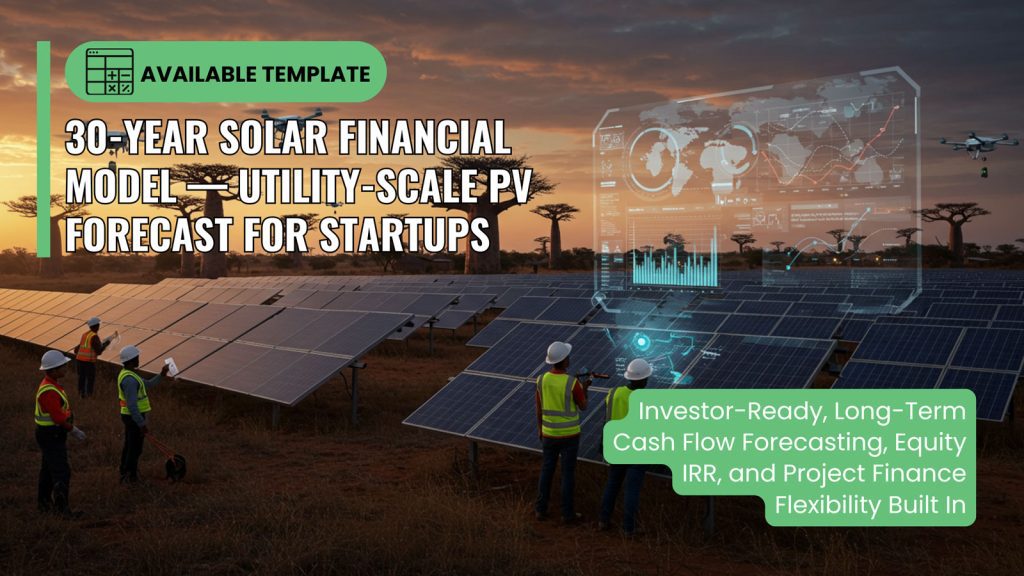
Whether you’re launching a utility-scale solar farm, preparing investor proposals for a startup solar power project, or conducting a feasibility study for a solar farm / solar plant, having the right solar financial model tool is critical.
This 30-Year Solar Financial Model Excel Template for startups is purpose-built for founders, project developers, analysts, and advisors seeking a funding-ready, investor-focused solar project finance model with robust flexibility.
By combining detailed assumptions, dynamic calculations, and intelligent outputs, this solar financial model Excel tool enables users to model solar project finance structures, run long-term return scenarios, and generate professional-grade dashboards with monthly cash flow forecasts, IRR, NPV, and more.
This Excel-based solar plant financial model template provides comprehensive financial modelling for solar PV projects.
As a renewable energy financial model Excel, it supports both small-scale solar business plan startup initiatives and large utility-scale solar projects. It delivers a 30-year view of operational and financial performance, integrating both debt and equity solar financing options.
By leveraging the power of spreadsheet automation, the model adapts to various business structures and markets, and can be utilised by clients worldwide—including those in Europe, Africa, South Africa, the US, and Australia—with region-specific tax, inflation, and currency inputs.
| Component | Description |
| Full Transparency and Editability | All formulas are fully visible and editable — no black-boxing. Users can trace calculations, understand linking logic, and customise as needed. Ideal for due diligence and professional audits. |
| No Advanced Knowledge Required | Designed for easy use. All complex logic has been pre-programmed — users only need to enter data into clearly marked fields — no formula tracing required for functional use. |
| Multi-Layer Output Structure | The model generates monthly, quarterly, and annual financial forecasts. This supports investor reporting, internal cash flow planning, and submissions to funders at different levels of detail. |
| 30-Year Financial Modelling Horizon | Unlike most templates limited to 5–10 years, this model supports a full 30-year solar financial model Excel — aligned with the real lifecycle of solar PV infrastructure. |
| Debt and Equity Financing Integration | Built-in logic supports debt and equity solar financing templates, including interest-only periods, grace periods, balloon repayments, and multi-tier funding structures. |
| Dynamic IRR and ROI Dashboards | Separate calculations for Project IRR and Equity IRR, plus visual dashboards showing return timelines, breakeven points, and investor profitability. |
| Scenario Testing and Sensitivity Analysis | Test the impact of changes to PPA tariffs, O&M costs, capital cost escalations, degradation, subsidies, and FX. This allows for credible long-term energy modelling. |
| Utility-Scale and Startup Ready | Whether you’re a solar startup or IPP, the model is flexible for different project scales. Adapt CAPEX, production size, and financing assumptions as needed. |
| Excel-Based for Maximum Compatibility | Fully unlocked Excel model for solar PV plant project financing, compatible with all Excel versions. |
| Global and Emerging Market Adaptability | Designed to support solar models for Africa, South Africa, Asia, Europe, and global projects — with adjustable tax, inflation, PPA escalation, and currency fields. |
| Investor-Ready Outputs | Includes financial statements, IRR charts, monthly cashflow solar project forecasts, and lender/VC-friendly visuals. Optimised for use in pitch decks, grant proposals, and bid responses. |
The use of this financial model is solely at the user’s own risk. Best Financial Models provides the template as a tool to assist users in their business planning and decision-making processes. However, the responsibility for adhering to the model’s instructions and guidelines lies entirely with the user. Best Financial Models cannot and will not be held liable for any inaccuracies, errors, or unintended outcomes resulting from the user deviating from the prescribed usage, including but not limited to the deletion, addition, or modification of rows, columns, formulas, or any other components of the model. Users are strongly advised to exercise caution when making any changes to the model to ensure its integrity and reliability are maintained.
| Business Type | Solar Energy |
|---|---|
| File Format | Microsoft Excel |
A solar financial model Excel is a structured spreadsheet that forecasts a PV project’s revenues, costs, debt service, and investor returns over its life. Our BFM solar financial model Excel covers up to 30-year projections and includes tariff escalation, degradation, and losses.
It calculates IRR, NPV, payback, DSCR, and LLCR, with transparent schedules for CAPEX, OPEX, working capital, and tax. This lets you test bankability, compare cases (PPA vs. merchant), and present a clear investment case to lenders and DFIs. The template includes dashboards, scenario toggles, and print-ready outputs for feasibility studies and funding packs.
A professional solar project finance model XLS integrates full financial statements—including income statement and cash flow—for construction and operations. The BFM template layers in debt sculpting, fees, grace periods, interest during construction, and refinancing logic. It models PPA terms, curtailment, and degradation, then computes project IRR and equity IRR, alongside DSCR/LLCR tests for lenders.
You’ll find input controls for tariffs, inflation, exchange rates, module replacements, and reserve accounts. Outputs include covenant checks, sensitivities, and summary dashboards. Everything is unlocked, documented, and structured so analysts can audit assumptions and advisers can adapt it for investment memos or lender models.
Our solar PV financial model follows a clean modular layout: Inputs → Calculations → Outputs. Inputs capture capacity, irradiation, PR, degradation, EPC/BoP costs, O&M, insurance, tariffs, escalation, taxes, and financing ratios. Calculations handle generation, losses, revenue, operating expenses, depreciation, tax shields, and debt schedules with sculpting to target DSCR.
Outputs show 30-year statements, IRR/NPV, DSCR/LLCR, and lender covenants. The Excel workbook also includes scenario selectors (base/low/high), sensitivity tables (tariff, CAPEX, leverage), and visual dashboards. This structure ensures auditability and helps investors understand what drives value in a utility-scale solar power plant project.
In a solar power project financial model, the PPA engine sets contract tenor, tariff start, indexation, and caps/floors. Our BFM Excel template lets you define annual generation, curtailment, take-or-pay logic, and CPI- or fixed-step escalation. Revenues flow into cash-flow waterfalls with OPEX, reserves, and debt service to produce DSCR and LLCR metrics.
You can compare PPA vs merchant or blended sales, test termination scenarios, and model step-downs after offtake expiry. The revenue schedule feeds IRR/NPV and covenant checks, giving lenders evidence that the project can service debt under conservative assumptions.
Key CAPEX drivers in a solar plant financial model Excel include modules, inverters, structures, cabling, land, grid connection, development fees, IDC, and contingencies. OPEX covers O&M, spares, cleaning, insurance, land lease, wheeling, and admin. Our solar financial model in Excel separates EPC and owner’s costs, applies construction timing curves, and supports component repowering/replacement mid-life.
You can escalate OPEX, add variable costs per MWh, and include reserves for major maintenance. These items roll into unit economics (LCOE), profitability metrics (IRR/NPV), and lender ratios (DSCR/LLCR), helping you justify tariff bids or negotiate PPA terms.
Yes—this renewable energy financial model Excel is fully country-agnostic. In Inputs, set currency (ZAR, USD, etc.), inflation, tax regime (capital allowances, loss carryforwards), withholding, VAT treatment, and incentives. You can adapt exchange-rate dynamics for imported CAPEX and index the PPA to local CPI.
The solar project finance model also supports different depreciation systems, the minimum alternative tax, and the standard reserve requirements for DFIs. Because the workbook is unlocked and documented, advisers can use it to apply for grants, carbon credits, or net metering. The structure suits projects across South Africa, the SADC region, and international markets.
The solar PV system financial model Excel delivers full financial statements, cash waterfalls, equity distributions, IRR/NPV, payback, and DSCR/LLCR profiles. Dashboards summarise capacity, generation, tariff, costs, leverage, and returns with charts for lenders and investors.
You’ll also get sensitivity tables (tariff, CAPEX, OPEX, degradation, leverage) and scenario toggles to compare base, downside, and upside. A covenant page flags DSCR breaches and minimum equity needs. This financial model template supports feasibility studies, investment committees, and data-room sharing, making it a bankable starting point for solar project finance analysis.
This solar financial model is built for developers, financial analysts, banks, DFIs, advisors, and EPCs. If you’re preparing an investment memo, lender case, or bidding on a utility-scale project, the BFM Excel template speeds up diligence while keeping assumptions transparent.
Teams can tailor leverage, tenor, grace, and sculpting to meet DSCR targets, then test tariff headroom and equity returns. Because it’s Excel, it fits existing workflows and can be merged with portfolio tools. New teams benefit from the documentation; senior modellers get a robust base that avoids reinventing core project finance mechanics.
By default, the solar project finance model assumes a 30-year term, matching the PV asset life. You can shorten the horizon to align with PPA tenor or extend to reflect repowering and tail revenue. The BFM solar financial model Excel includes replacement cycles, degradation, and optional terminal value methods.
This helps test refinancing, reserve releases, or life-extension economics. Forecast length directly affects IRR/NPV and DSCR/LLCR patterns, so scenario toggles show how tenor, leverage, and tariff paths shift debt capacity and equity returns under conservative and upside cases.
The Best Financial Models solar financial model Excel template is a bank-grade, unlocked workbook with 30-year forecasts, PPA mechanics, DSCR/LLCR covenant tests, and clear IRR/NPV outputs. You get scenario toggles, sensitivity tables, dashboards, and documented logic that advisers can audit quickly.
Compared with generic spreadsheets, it includes construction curves, refinancing, and repowering options. The model accelerates feasibility studies, investor pitches, and lender submissions—saving weeks of build time while improving credibility. It’s designed for South Africa, SADC, and global projects, and integrates smoothly with standard Excel workflows.
Need another Financial Model Template?
Visit our BFM Financial Model Template Store
This professional Solar Financial Model in Excel has been exclusively designed for utility-scale solar projects. It includes detailed forecasts, PPA cash flows, IRR, and scenario dashboards—built for bankable solar project finance analysis.
This 30-Year Solar Financial Model Excel Template for startups is purpose-built for founders, project developers, analysts, and advisors seeking a funding-ready, investor-focused solar project finance model with robust flexibility.
This solar financial model template in Excel is a structured spreadsheet that forecasts a solar PV project’s revenues, costs, debt service, and investor returns over its life.
This solar farm financial model Excel workbook includes tariff escalation, degradation, and losses. It includes transparent schedules for CAPEX, OPEX, working capital, and tax. This lets you test bankability, compare cases (PPA vs. merchant), and present a clear investment case to lenders and DFIs.
The template includes dashboards, scenario toggles, and print-ready outputs for feasibility studies and funding packs.
By leveraging the power of spreadsheet automation, the model adapts to various business structures and markets, and can be utilised by clients worldwide—including those in Europe, Africa, South Africa, the US, and Australia—with region-specific tax, inflation, and currency inputs.
R4,999.00
We accept various methods of payment, including Visa, Mastercard, and EFT.
Our site is secured with SSL certification and we do not store any of your payment details.
Immediate access to your chosen financial model, compatible with Excel or Google Sheets.
Our templates are designed for global use, featuring support for all major currencies.
Utilise this investment-grade Solar Financial Model Excel template in conjunction with our custom Business Plan and Feasibility Study services at JTB Consulting to enhance your funding proposal and establish investor trust.
We don’t spam, and you can always opt out at any time.
